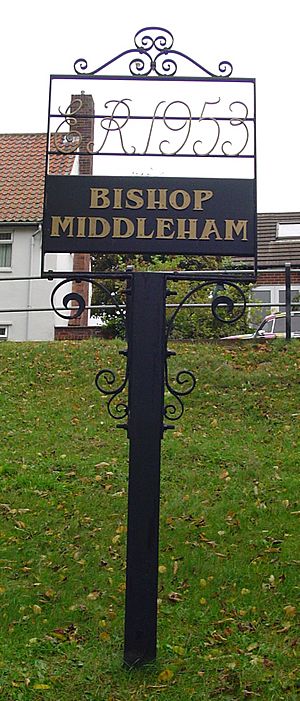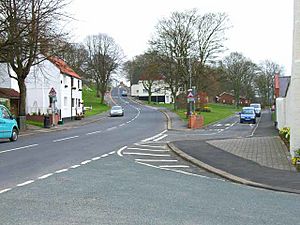Bishop Middleham facts for kids
Bishop Middleham is a village in County Durham, England. About 1,275 people lived here in 2011. It is located near Sedgefield.
Contents
Discovering Bishop Middleham's Past
Bishop Middleham sits in a dry valley. It is about 9 miles (14 km) south-east of Durham.
Early Times
People have lived in this area for a very long time. The first signs of people are from the Neolithic (New Stone Age) or Bronze Age. Simple flint tools, like an arrowhead, have been found. These tools were likely used by early hunters. By the Bronze Age, farming was common here.
Later, in the Iron Age, we find the first evidence of burials. At least six graves were found in a small cave. A small glass bead with white spirals was also found. It might have come from an Iron Age grave.
Roman Road and Treasures
Bishop Middleham was on an important Roman road called Cades Road. This road went right through the village. Even with this road, no Roman buildings have been found yet.
However, several Roman objects have been discovered. One is a small bronze statue of a Roman god. More unusually, four Roman pans were found stacked together. They were decorated to look like silver. These pans might have been used for religious purposes. Finding these items suggests there might be an undiscovered Roman temple nearby.
Anglo-Saxon and Medieval Life
There is not much clear evidence of Anglo-Saxons living here. But the name "Middleham" comes from Old English. It means "middle settlement" or "farm." This suggests people lived here by the 9th or 10th centuries.
In 1146, the Church of Middleham was given to the Prior and Convent at Durham. This is the first time the village is mentioned in records. In 1183, a survey called the Boldon Book was made. It showed about 32 households in the village. This survey even named some people, like Arkil and Ralph.
Bishop Middleham was a favorite home for the Bishops of Durham. Two bishops even died here. Today, only earthwork remains show where the Bishops' residence once stood.
Later Centuries
By the late 1300s, the Bishop of Durham stopped using the castle as a home. The buildings and land were rented out. Over the centuries, the castle and its deer park were owned by different families. These included the Eure family and the Surtees family.
In the 18th century, Robert Surtees lived nearby. He was a famous historian. He wrote about Bishop Middleham and its castle in his book, History of Durham, in 1823. He is buried in Bishop Middleham church.
Village Life in the 1800s
By the 19th century, the village had four pubs and a brewery. There were also a few shops. Most people in the village worked in farming. Some coal mining also took place. The remains of an old wagonway, used for carrying coal, have been found. A main railway line also ran close to the village.
In 2012, a community website was started. It helps local people stay updated on news and events.
St Michael's Church
The Church of St. Michael stands on a hill south of the village. It is thought to have been built around 1230. In 1146, it was given to the prior and convent of Durham. It is an old building in the Early English style. It has a nave, chancel, aisles, and a bell turret at the west end.
Local Nature Reserve
The Bishop Middleham Community Wildlife Garden is a special place. It covers about 0.87 hectares. It has been named a Local Nature Reserve by Sedgefield council. This means it is protected for its wildlife.
Famous People from Bishop Middleham
- Samuel Taylor Coleridge: A famous poet who stayed here in 1801.
- Thomas Hutchinson: A scholar born here in 1698.
- Sir Henry Taylor: An author and friend of William Wordsworth. He was born in Bishop Middleham.
- Muriel Young: A theatre and television actress and TV personality. She was born here in 1923.
How Bishop Middleham is Governed
National Government
Bishop Middleham is part of the Sedgefield area. This area elects a Member of Parliament (MP) to the House of Commons in London. The MP represents the people of Sedgefield in the UK Parliament. Currently, the MP is Phil Wilson from the Labour Party. Before him, the MP for Sedgefield was Prime Minister Tony Blair.
Local Government
Locally, Bishop Middleham is run by the Bishop Middleham Parish Council. This council has 9 Councillors. They are elected every four years. Each year, the council chooses one member to be the Chairman for 12 months. The council meets once a month, except in July and August. Meetings are held in the Bishop Middleham Village Hall.



